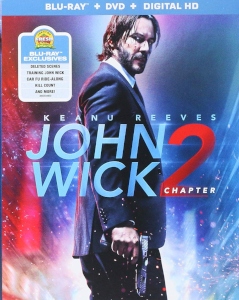There are many impressive things about the “John Wick” films – the second of which, “John Wick: Chapter 2” (February 2017), recently hit HBO – even beyond the lead character’s kill count of 204 between the two pictures. What I like most about them, though, is that they simplify and refresh the genre, reminding us why we love action films in the first place.
As with the 2014 debut, where our hero tracks down a car thief (and 75 henchmen) who kills his puppy, John Wick (Keanu Reeves) is a hit man trying to get out of the game — with a spectacular lack of success.
As per the rules of the Continental crime syndicate/hotel chain, Wick owes a favor to fellow member Santino D’Antonio (Riccardo Scamarcio), and must honor the marker. It’s distasteful to him, but Wick has no choice but to assassinate D’Antonio’s sister, Gianni (Claudia Gerrini). Then, for the sake of appearances, Santino puts a $7 million bounty on John, giving him more baddies to gun down in the film’s second half.

“John Wick: Chapter 2” (2017)
Director: Chad Stahelski
Writer: Derek Kolstad
Stars: Keanu Reeves, Riccardo Scamarcio, Ian McShane
Easily accessible action
That’s all there is to the plot, but its straightforwardness makes the movie (like the first one) accessible. Everything with the Continental is insane, but it’s played straight by every actor, including Ian McShane as boss Winston. (A Continental TV show is now in the works.)
Lesser action films try too hard to sell their complex plots, and a lot of them end with the viewer thinking “Well, that won’t hold together if I think too hard about it.” But similar to classics like “First Blood” (1982), the “Wick” films just are what they are; they will never pull a fast one on you.
The stripped-down approach works for characterization, too, particularly Wick, who as a typical noir hero loathes his job even though he’s the best in the world at it. Santino at one point accuses John of secretly loving killing people, but I don’t believe it.
John’s lack of dimension is what makes him a great action hero. Screenwriter Derek Kolstad knows that plastering depth or layers onto this man would come off as pretentious, and the films are smart for not trying it.
Continental ops
The world of the Continental – a safe haven, shopping center, restaurant, bar, etc. – features some employees who are gleeful about their jobs. It’s an interesting flipping of the cliché when the armorer practically drools over all the cutting-edge weaponry, but John stoically appraises the pieces for their functionality.
At the end of this scene (and others like it), the Continental employee wishes John happy hunting; he pauses for a minute and then gives a slight nod – and we can read so much delicious emptiness into it.
The action choreography is a revelation, like stepping into a light after the long tunnel of all those films from 2005 to 2015 that were edited in a rapid-fire style to try to hide bad choreography or bad special effects.

Combining Asian martial arts gangster films and first-person shooter video games into “gun-fu,” director Chad Stahelski – himself a veteran choreographer – gives us clean frames and a reasonable pace so we can appreciate the artistry of John’s fights and kills.
Racking up the kills
The sheer volume of the kill count – 128 in “Chapter 2,” which beats the first film’s 76 and even “Hot Shots Part Deux’s” (1993) supposed record of 114 – is so staggering as to border on amusing. But it fits: Known as “the Boogeyman” by those in “the business,” Wick is himself an absurdist creation. Why can’t the crime lord just finish off this one man? Well, because it’s John Wick; ’nuff said.
He legendarily once killed three men with a pencil – “a f***ing pencil!” as Peter Stormare’s Russian kingpin puts it. That specific moment remains the stuff of legend, but in “Chapter 2,” he pulls off a similar trick. Wick can also speak every language known to man, apparently; he exchanges witticisms in ASL with Ares (Ruby Rose) in this one.
Not only do the filmmakers allow us to appreciate the choreography, but also the relationships between the hero and his enemies. Within the Continental’s walls, “business” is prohibited, so rivals can talk over a drink before getting back to it.
We begin to admire Wick
Albeit dark and twisted, there’s a sense of honor when John and Cassian (Common) both promise to kill each other quickly as a professional courtesy. The beautiful settings, from the twilight skyline of New York to Rome’s catacombs, enhance the notion that we’re not wrong to find beauty in one of the bloodiest films ever.
Certainly, the idea of a one-man killing machine is satisfying on a primal level, and that’s what Kolstad, Stahelski and Reeves tap into. While “First Blood’s” John Rambo has a moving backstory, a lot of us can’t personally relate to post-war trauma and mistreatment.
By contrast, we don’t know Wick’s full backstory, but with those nods of appreciation to his armorers, outfitters and sommeliers, he seems like a decent guy doing what’s necessary to survive in a messed-up world. Yes, we get swept up in the plight of John Wick because he’s a cool action hero, but also because he’s the only possible audience surrogate in these movies.

